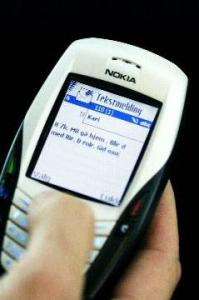The newest language for mobile text messaging looks like hieroglyphics and sounds like a caveman. The language is Zlango, and its creators aim to inject whimsy and emotion into text messaging while reducing the number of keystrokes needed to get the point across.
"SMS is the driest of all forms of communication," Zlango founder and Chief Executive Officer Yoav Lorch told UPI. "SMS," short for "short messaging service," is how much of the rest of the world refers to text messaging.
Americans send 8 billion text messages every month, according to Cellsigns, a real-estate firm that alerts buyers via SMS.
Zlango's colorful picture language -- full of people with Simpsons-yellow skin -- provides this "missing element of emotion," Lorch continued. "It's more fun; it's a richer experience" to send and receive ZMS messages, he said.
It all started when Lorch tried to streamline text messages. He found that even when you cut words down to the bare minimum necessary for understanding, you could only cut 20 percent. Only a system that cut out 80 percent would catch on, Lorch thought, and from there the idea of a picture-based language was reborn.
You want talk Zlango? (I meant to leave the "to" out.) You can! The 200 symbols don't sound poetic or grammatically correct when read out loud, but who sends poetry by SMS? Lorch maintains that Zlango mangles language less than some of the abbreviations text messagers have come up with.
On the other hand, he continued, "I find myself and my co-workers talking (in Zlango-speak)," he said. "When someone says a meeting is about to start, instead of saying, 'I'll be there in a minute,' I say, 'Me come, me come.'"
This might worry those Americans who feel that Zlango's target audience, those aged 8 to 28, are reading and writing less -- and less well.
"It's actually not an uncommon phenomenon for something that starts out as cutesy ... (to be) integrated into everyday language," Lauren Squires, a graduate student about to start a Ph.D. in linguistics at the University of Michigan, told UPI. Squires' research focuses on language use and technology.
"It's like people saying BTW or OMG in everyday language," she continued, citing the instant messaging abbreviations for "by the way" and "oh my God."
One reason Zlango-speak may have caught on in the office is that it is part of the employees' social group, Squires added. "It becomes an in-group joke."
It is true that in the United States there is alarm about messaging contributing to the deterioration of language, Squires said.
"I think (the fears are) a bit overblown, because language is always changing," she added.
And as for fears your children will think only in pictures and talk only like cavemen, "I have a hunch that kids are writing of their own will more, and earlier, than before (these technologies) became popular," Squires said.
"They probably know the difference between the language of text messaging and the language they use to speak to adults," she added.
Zlango really is a different dialect. It isn't immediately understandable: the idea of "being able to" is conveyed by a beefy superhero flying to save the day, and "but" and "if" are twisted arrows.
Some of the icons, like a hand with only the middle finger extended, are fairly unmistakable.
After looking over a partial dictionary of 120 of the symbols for about 10 minutes, UPI had it down.
Pressing the "pound" key gives each picture a one-word caption, so the uninitiated can see that "puzzle, man pointing out, man pointing at himself, face with tears" means "Without you, me cry."
Lovey-dovey Zlango icons like "miss you" are popular, Lorch said, and so is that oft-used curse word conveyed by a brown pile surrounded by flies.
A quick scan of UPI's most recently sent text messages revealed that almost everything there was Zlango-translatable.
Lorch emphasized that ZMS is not an all-or-nothing technology. Any message can have any combination of pictures and written text, and he doesn't expect that ZMS will take over for regular text messaging completely.
Most phones with color screens can support the free Zlango download. "(The icons) don't look good on a black and white screen ... but the file is not large, and doesn't demand a 3G platform," Lorch said.
At the moment, Zlango's Ramat Hasharon offices are the only place where people are sending the picture messages. In July Zlango will launch in Israel, and by the end of the year "there will be a number of countries where Zlango is available," Lorch said.
The company, which makes its money by taking a cut of the mobile operator's fee to send a message, is currently cultivating relationships with more than 20 mobile operators, mostly in Asia and Europe, Lorch said.
Dealing with the giant U.S. mobile operators is a little trickier, but Lorch, who has spent several years living in the United States, said he has a feeling it'll catch on in there, even though text messaging is just beginning to be popular.
How big is Zlango going to be? "I think people will read and write books in Zlango," Lorch, a former newspaper publisher, said.
"I wouldn't be surprised if novelty books at the checkout line in Barnes & Noble were written in Zlango," Squires said. "But serious works of fiction? I'd be very, very surprised."
Copyright 2006 by United Press International
























